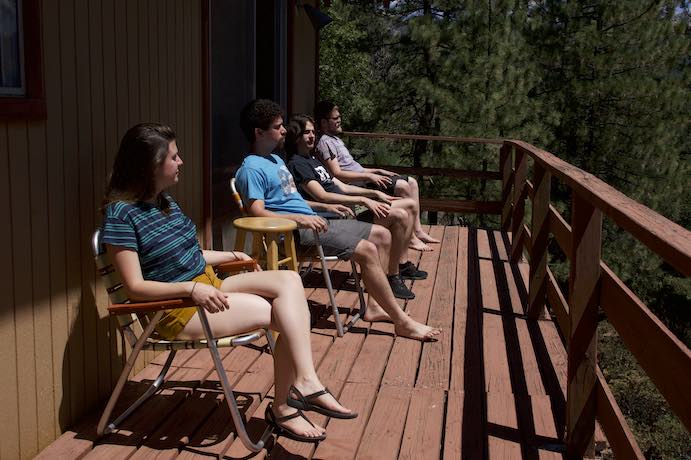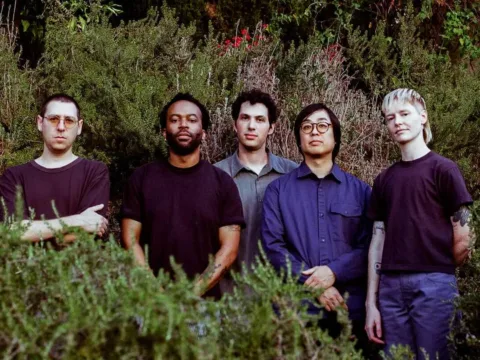The Los Angeles Electroacoustic Ensemble’s debut self-titled album represents an exploration of electronic music in a contemporary chamber music context. Released January 31, 2021, the album is a compilation of 11 works by the band members that combine experimentation with modern technology. The Los Angeles Electroacoustic Ensemble is Marcus Carline (electronics, guitar, voice); Glen Gray (electronics, modular synthesizer, mandolin); Zachary Kenefick (electronics, modular synthesizer, saxophone) and Cristina Lord (electronics, synthesizers, voice).
The album begins with “Letters,” written by Marcus Carline, who patched a QWERTY keyboard sampler with recordings of the band members saying each letter. The group then improvised with the keyboard sampler, explicitly making the laptop (and the person at it) the instrument. The resulting work cleverly plays with tempo and duration, removing any concept of tone in order to emphasize the value of time itself to sculpting sound.

When working with electronic instruments, musicians generally avoid clipping the signal. However, in “Gossip,” Cristina Lord guides the performers to intentionally overload these signals. Ringing electronics crackle, swelling dynamically in a magnetic cloud of distortion as the performers improvise and play off each other’s gestures. Both “Gossip” and the following work, Lord’s “Poison Tree,” are from a collection entitled Etudes for Sine Waves. All tones are created by sine waves, and in the latter piece, modulating reverberations softly float in and out of range. Texturized, shimmering notes are then layered onto the first tones, and are finally followed by a soloist playing over the first two layers, creating a tiered abstraction of sound.
“We Study” by Zachary Kenefick is an arrangement of the initial ensemble, which consisted of two musicians on electronics and one cellist accompanying a trio of dancers who thematically encompassed bodies in space and the groupings they can form. For this arrangement, Kenefick added another musician to the ensemble and swapped the cello for electric guitar, shifting the focus more toward how electronic instruments representing sonic bodies play together within an acoustic space. “We Are the Old Guard,” also written by Kenefick, combines improvisation with unconventional composition techniques such as data entry. The players are conducted by pre-determined sound, coupled with their own interpretation—hardly a challenge to the compositional form at large.
The next two pieces, “Cornetto and Saw” and “Bontempi Organ” composed by Glen Gray, are duets written as parallel inquiries into the concept of sampling in a chamber setting. In “Cornetto and Saw,” the samples of the cornetto are juxtaposed with samples of a square wave, while “Botempi Organ” uses samples from a bontempi air organ. Layered samples create acoustic-sounding textures while the intrusion of electronic sound disrupts the acoustic groundwork, merging the two forms of instrumentation together.
Gray’s improvisation for guitar, mandolin and two laptops, “Jam,” asks the players to bridge the acoustic and electronic instruments, interspersing soft plucks with static-like feedback. Similarly, Kenefick’s duet, “Slough,” combines antiphonal acoustic elements with a large mass of electronic sounds, presenting the laptop as orchestral both in size and as a vocal accompaniment.

“Astronauts” by Carline uses a computer-randomized shuffle of YouTube videos to pull together unintelligible snippets while a trio of sequencers gives shape to the chaotic noises. Fleeting flashes from the lives of different people around the world flicker throughout “Astronaut,” while the sequencers glimmer in the background, giving off the impression of a lone cosmonaut watching Earth from afar, their spacecraft beeping in suspended space behind them.
Lord’s “Contact” finishes the album, utilizing chance operation with multiple radios being played and re-tuned in real-time. A random collage of samples plays in succession, slowly giving form to a rhythmic pattern. The samples evolve into a series of drones, representing unity between the various sounds as they turn into one singular tone. Similar to how an acoustic note is formed through an oscillation of a singular particle, these samples “bounce” to create a note.
Throughout the album, this electronic reconstruction of an acoustic note through overloaded signals, reverberation, and sampling gives rise to an electronic chamber performance similar to any other ensemble combining a variety of instruments to create a symphonic performance. While the essence of the Los Angeles Electroacoustic Ensemble’s album aims to challenge conventional notions of an ensemble, many of these poststructural themes are difficult to discern through an auditory experience without a written explanation. Some of the works seem to execute the presupposed theories they present successfully, such as in “Letters” and “Contact.” However, others seem to purposefully avoid any compositional forms to a fault–leaving the listener grasping in the dark for some larger meaning–and some pieces feel like they missed the mark completely or brought up questions frequently asked by other composers. Overall, the album rebukes conventional ideas in some ways that are novel, but in other ways feel overwrought or indeterminate.
I CARE IF YOU LISTEN is an editorially-independent program of the American Composers Forum, funded with generous donor and institutional support. Opinions expressed are solely those of the author and may not represent the views of ICIYL or ACF.
A gift to ACF helps support the work of ICIYL. For more on ACF, visit the “At ACF” section or composersforum.org.
























